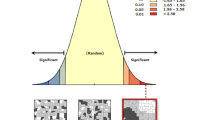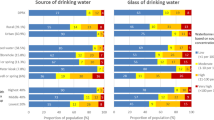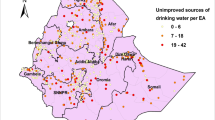Abstract
The World Health Organization (WHO)/United Nations Children’s Fund (UNICEF) Joint Monitoring Programme (JMP) for Water Supply and Sanitation was designed to provide reference figures for access in individual countries to safe water. The JMP is based on non-administrative or nongovernment data from national-level surveys such as the Multiple Indicator Clusters Survey (MICS) or Demographic Health Survey. In the 2007 JMP report, India is noted to have water supply coverage of 89% (95% in urban areas and 85% in rural areas) compared to the Government of India estimates of 95%. The central state of Madhya Pradesh is noted by the Government of India to have coverage of 60%. However, the definition of access to safe water currently does not consider the quality or safety of the water being consumed. This paper, therefore, presents results from the application of a statistical tool (random multiple cluster technique—termed Rapid Assessment of Drinking Water Quality [RADWQ]) to Indore Zone in Madhya Pradesh. When results provided by the RADWQ technique are compared to the JMP MICS data, coverage levels reported in the JMP are reduced by up to 40% due to the high risk of microbiological (thermotolerant coliforms) contamination. In Indore Zone, the coverage of safe water reduced from 42% to 25% through the inclusion of the water safety parameters. The study recommends the inclusion of water quality/safety data in reported data under the UNICEF/WHO JMP.
Similar content being viewed by others
References
Bartram, J., & Balance, R. (1996). Water quality monitoring: A practical guide to the design and implementation of freshwater quality studies and monitoring programmes. London: Chapman & Hall.
Baumgart, H., & Sperling, F. (1984). Monitoring stations and water quality measurements on the river Lippe: Equipment-results-costs. Water Science and Technology, 16, 327–346.
Bureau of Indian Standards (BIS) (1991). Drinking water quality standards.
Canter, L. (1985). River water quality monitoring. Chelsea: Lewis.
Chen, Y. X., Lin, M. Q., He, Z. L., Xiao, Y. D., Chen, C., Min, D., et al. (1996). Relationship between total fluoride intake and dental fluorosis in areas polluted by airborne fluoride. Fluoride, 29(1), 7–12.
Dissanayake, C. B., & Rohana, C. (1999). Medical geochemistry of tropical environments. Earth-Science Reviews, 47, 219–258
Government of India (CENSUS) (2001). National census data. New Delhi, India: Government of India.
Herricks, E. (1982). Biological monitoring: Receiving system methodology based on community structure. Water Research, 16, 141–153.
Howard, G., Ince, M., & Smith, M. (2003). Rapid assessment of drinking water quality: A handbook for implementation. Unpublished draft, WHO/UNICEF/WEDC, WEDC, Loughborough University, UK.
Kahama, R. W., Karuiki, D. N., & Njenga, L. W. (1997). Fluorosis in children and sources of fluoride around lake Elimentaite region of Kenya. Fluoride, 30(1), 19–25
Ortiz, D., Castro, L., Turrubiartes, F., Milan, J., & Diaz Barriga, F. (1998). Assessment of exposure to fluoride from drink water in Durango, Mexico, using a geographic information system. Fluoride, 31(4), 183–187.
Planning Commission, Government of India (2007). Eleventh five-year plan (2007–2012), rural drinking water and sanitation.
Sanders, T. G. (1980). Water quality as a stochastic process. In Proceedings of the ASCE national convention, 14–18 April. Portland, OR.
Sanders, T., Ward, R., Loftis, R., Steele, T., Adrian, D., & Yevjevich, V. (1983). Design of networks for monitoring water quality. Highlands Ranch: Water Resources Publications LLC.
US Geological Survey (1977). Elements needed in design of a ground-water-quality monitoring network in the Hawaiian Islands. Water-Supply Paper 2041.
WaterAid India (2005). Water and sanitation in Madhya Pradesh: A profile of the state, institutions and policy environment. India: WaterAid Publication.
WaterAid India (2006). Water and sanitation in rural areas of Madhya Pradesh. India: WaterAid Publication.
Whitfield, P.H. (1988). Goals and data collection design for water quality monitoring. Water Resources Bulletin, 24(4), 775–780.
WHO (2004). Guidelines for drinking water quality: Recommendations (Vol. 1, 3rd Ed.). Geneva: World Health Organization. Retrieved from http://www.who.int/water_sanitation_health/dwq/gdwq3rev/en/index.html.
WHO (2005). Water-related diseases, fluorosis; the disease and how it affects people. Geneva: World Health Organization.
WHO/UNICEF (2008). Joint monitoring programme for water supply and sanitation (JMP), progress on drinking water and sanitation: Special focus on sanitation. New York: WHO/UNICEF.
Author information
Authors and Affiliations
Corresponding author
Rights and permissions
About this article
Cite this article
Godfrey, S., Labhasetwar, P., Wate, S. et al. How safe are the global water coverage figures? Case study from Madhya Pradesh, India. Environ Monit Assess 176, 561–574 (2011). https://doi.org/10.1007/s10661-010-1604-3
Received:
Accepted:
Published:
Issue Date:
DOI: https://doi.org/10.1007/s10661-010-1604-3




